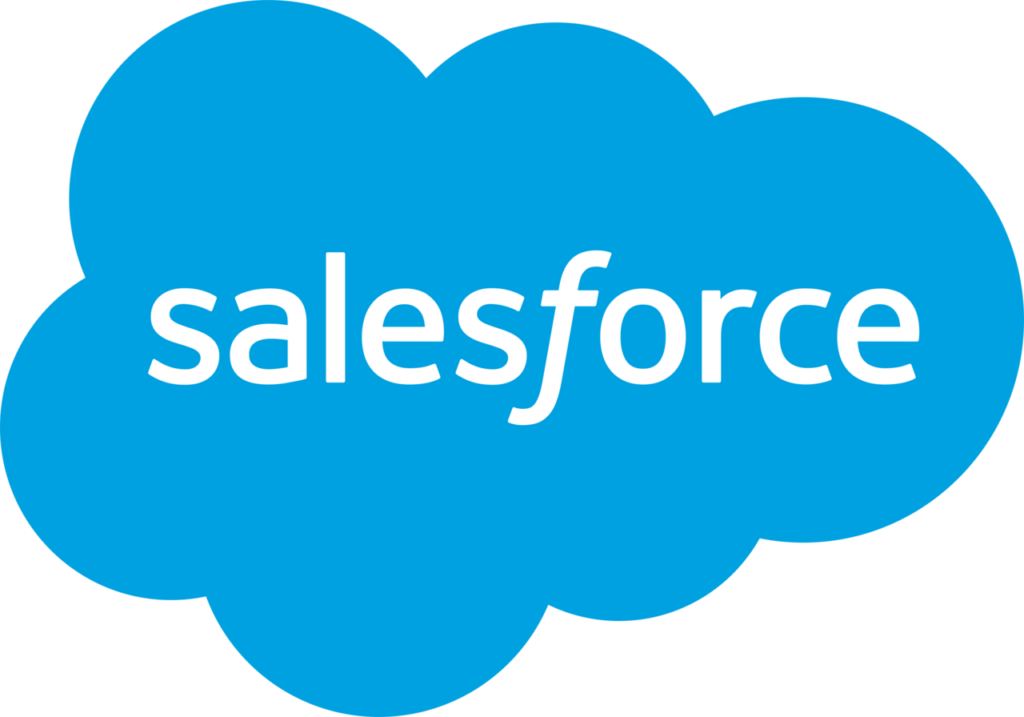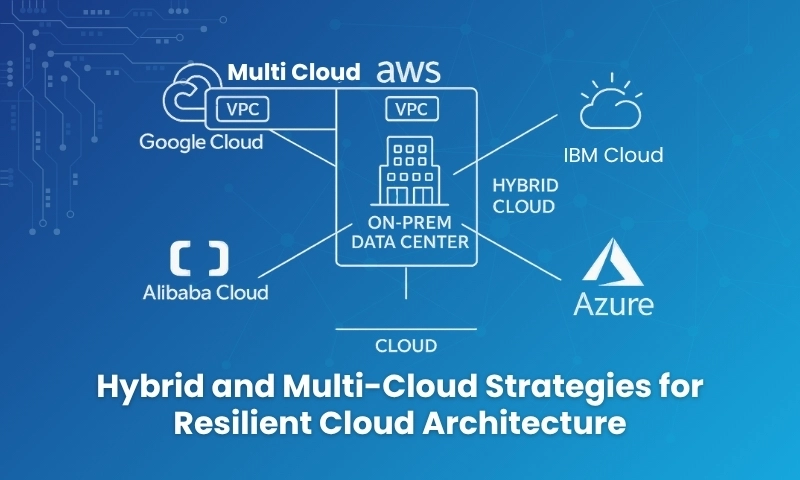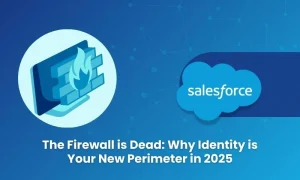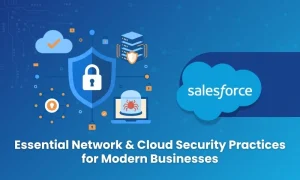By 2025, virtually every enterprise operates in the cloud: few operate well across it. The question is no longer “should we go hybrid or multi-cloud?”: it’s “how do we design for portability, resilience, and intelligence across environments?”
Moving beyond stopgaps, hybrid and multi-cloud are strategic foundations for agility. Advances in Kubernetes, unified governance, and AI-driven FinOps allow organizations to orchestrate workloads across all environments. This modernization secures full compliance and control while driving efficiency.
This Blog explores how forward-thinking enterprises can design and optimize hybrid and multi-cloud environments for performance, security, sustainability, and cost efficiency in 2025 and beyond.
The Evolving Multi-Cloud Capabilities Landscape
Cloud architectures have matured from single-provider deployments into complex, federated ecosystems.
Organizations now demand portability, visibility, and control — not just compute and storage.
Key 2025 shifts include:
- Kubernetes as the Universal Control Plane:
EKS, AKS, and GKE unify container management across clouds. - Cross-Cloud Governance via Anthos and Azure Arc:
Policy and compliance extend seamlessly from private to public clouds. - AI Ops for Proactive Optimization:
Machine-learning-driven insights now handle incident detection and cost forecasting. - FinOps & GreenOps:
FinOps brings financial discipline; GreenOps embeds sustainability and carbon intelligence into cloud decisions. - Zero Trust Everywhere:
Identity-centric security models replace traditional perimeter defense.
Modern enterprises no longer talk about “migration.” They talk about multi-cloud integration and hybrid modernization.
Understanding Hybrid Cloud Infrastructures and Multi-Cloud Solutions
Hybrid Cloud: Integration for Control and Compliance
A hybrid cloud infrastructure connects private or on-premise environments with one or more public clouds. This allows enterprises to modernize legacy workloads while maintaining compliance for regulated data.
Example:
A healthcare provider keeps patient records on-prem (HIPAA compliance) while using Azure or AWS for AI diagnostics and analytics.
Multi-Cloud Solutions: Diversification for Resilience
A multi-cloud solution spans two or more public clouds — e.g., AWS for compute, Azure for business apps, GCP for analytics. It eliminates vendor lock-in and offers geographic and cost flexibility.
Example:
A SaaS firm runs its core services on AWS, its BI layer in GCP, and its enterprise integrations in Azure to optimize latency and performance.
Hybrid Multi-Cloud: The Governance Fabric
The hybrid multi-cloud model merges both, integrating private systems and multiple clouds under a single governance layer. This approach ensures unified policy, observability, and orchestration across diverse environments.
Hybrid Multi-Cloud Architecture Diagram:
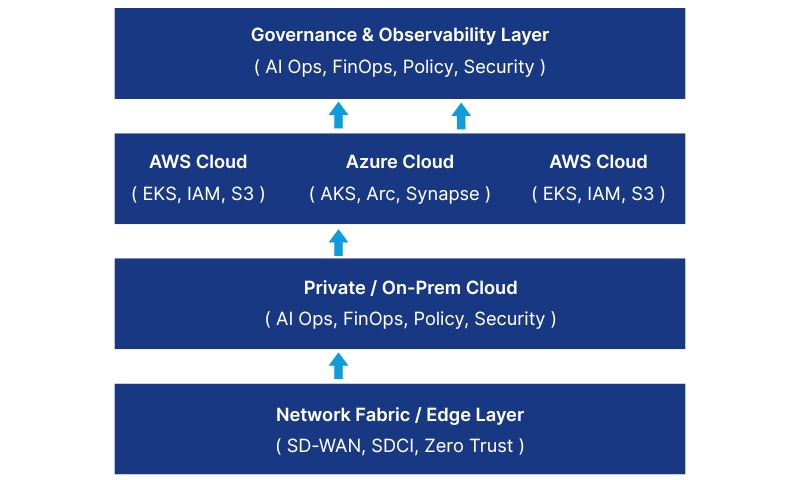
This architecture represents the hybrid multi-cloud platform — a unified digital backbone connecting on-prem, public, and edge environments.
Multi-Cloud Hosting and Network Architecture
In a hybrid multi-cloud world, the network is the architecture.
- Interconnectivity: Use AWS Direct Connect, Azure ExpressRoute, or Google Cloud Interconnect for deterministic bandwidth and latency.
Many enterprises now layer these with software-defined cloud interconnects (SDCI) via providers like Megaport or Equinix Fabric for multi-cloud routing. - SD-WAN and Network Mesh: SD-WAN overlays provide dynamic routing, security segmentation, and resilience.
- Identity Federation: Extend your IAM policies across clouds using SSO, OIDC, or workload identity federation. Azure AD, AWS IAM Identity Center, and GCP IAM can now interoperate under a Zero Trust model.
- Data Fabric: Adopt a unified namespace (via NetApp ONTAP, Databricks Unity Catalog, or Google’s DataPlex) to simplify governance across environments.
- Caching and Tiering: Place hot data near compute (edge/private), cold data in low-cost object storage (S3, Azure Blob, GCS), and sync via automated replication (AWS DataSync, Azure Arc-enabled Data Services).
Hybrid Cloud Deployment and Security Architecture
Security in 2025 hybrid architectures is no longer about firewalls — it’s about identity, telemetry, and trust boundaries.
Core Pillars:
- Zero Trust Everywhere: Verify each request — user, service, or workload.
Implement identity-aware proxies (Google BeyondCorp, Azure Conditional Access, AWS Verified Access). - Unified IAM: Enforce consistent roles and conditional policies across environments.
- Encryption by Default: Use KMS integrations (AWS KMS, Azure Key Vault, Google Cloud KMS) with key replication for compliance.
- SIEM & SOAR Integration: Aggregate telemetry via multi-cloud tools (Microsoft Sentinel, Chronicle, Splunk Cloud) for centralized visibility.
- Compliance Zones: Segment data by sovereignty requirements — e.g., host EU data in AWS Frankfurt or GCP Belgium regions.
The new security mantra: Identity is the new perimeter; telemetry is the new firewall.
Multi-Cloud Strategy: Migration and Modernization Roadmap
Successful hybrid adoption isn’t a linear migration — it’s an iterative modernization loop.
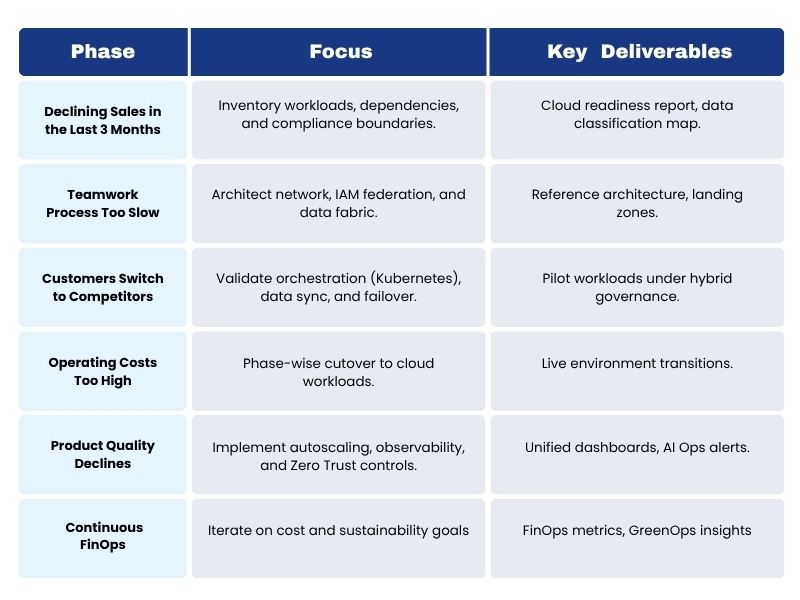
This feedback-driven lifecycle reflects how mature organizations evolve their hybrid architectures — continuously, not sequentially.
Multi-Cloud Platform Operations and Observability
Observability is now the backbone of multi-cloud reliability. Enterprises deploy AI Ops platforms that correlate logs, metrics, and traces from all clouds to identify anomalies automatically.
Modern Stack Example (2025):
- Telemetry: Prometheus + OpenTelemetry + Cloud-native agents
- AI Ops: Dynatrace, New Relic AI, or Google Cloud Operations Suite
- FinOps: CloudHealth, Azure Cost Management, GCP Billing API
- Automation: Terraform Cloud + ServiceNow + AI-driven orchestration
Together, they enable self-healing systems that adapt to performance, cost, and compliance triggers.
Multi-Cloud Access, Sustainability, and GreenOps
In 2025, every major cloud provider will offer carbon-intensity APIs and energy efficiency dashboards.
Modern hybrid strategies integrate these signals into workload placement logic.
- Carbon-Aware Scheduling: Route compute to regions using renewable energy grids.
- Lifecycle Optimization: Automate right-sizing, idle shutdowns, and heat-aware workload placement.
- GreenOps Dashboards: Combine cost, performance, and CO₂ metrics into FinOps governance reports.
- Secure Access: Apply conditional access policies to limit multi-cloud exposure without restricting innovation.
Sustainability is now inseparable from accessibility — the future of multi-cloud access is green by design.
Real-World Hybrid Multicloud Use Cases
Financial Services:
Private clouds maintain compliance; public clouds handle analytics and AI workloads.
Healthcare:
On-prem medical data linked with GCP AI models for diagnostics, maintaining HIPAA alignment.
SaaS Providers:
Distribute workloads across AWS, Azure, and GCP for latency and redundancy.
Manufacturing / IoT:
Edge compute feeds telemetry to hybrid cloud analytics for predictive maintenance.
The Future of Hybrid Cloud Platforms — Toward the Supercloud
As hybrid and multi-cloud environments mature, we’re witnessing the rise of the Supercloud — a cross-provider abstraction layer where governance, identity, and automation live above the infrastructure.
Superclouds unify:
- AI-assisted orchestration
- Policy-as-Code automation
- Multi-cloud service mesh
- Cross-domain FinOps visibility
The destination isn’t hybrid or multi-cloud — it’s an intelligent, self-optimizing cloud fabric that spans every layer of digital business.
Conclusion
The future belongs to organizations that treat hybrid and multi-cloud environments not as complexity, but as capability.By embracing Kubernetes, Zero Trust, AI Ops, and FinOps under a unified governance fabric, enterprises can build architectures that are secure, sustainable, and future-proof.
Hybrid and multi-cloud strategies in 2025 aren’t about where workloads run — They’re about how intelligently and responsibly they evolve.
